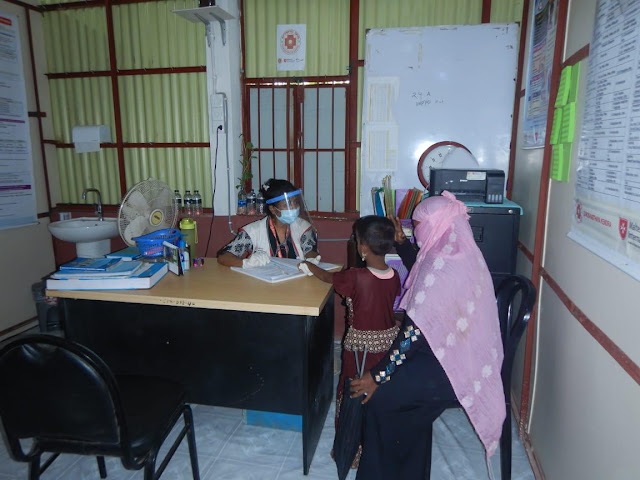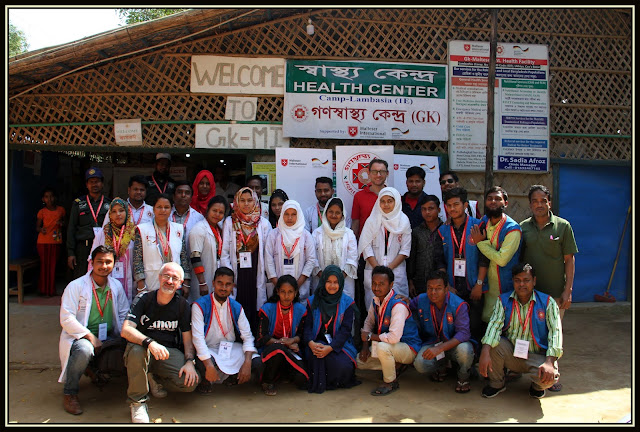If they make a little bit of money, one episode of illness can wipe them out.”
(Zafrullah Chowdhury)
 |
| Dr. Sadia. Cox's Bazar – 27 February 2020 |
More than a million Muslim-majority Rohingyas live in camps in Bangladesh, most of them arriving in August 2017 after fleeing genocide by Buddhist fundamentalists in Myanmar.
Three years have passed since
genocide sent hundreds of thousands of Rohingyas in Myanmar fleeing for their
lives, the majority into neighbouring Bangladesh.
Bangladesh is hosting around 1.1
million Rohingya refugees with about three quarters of those fleeing to the
country in or after August 2017.
When I was in Bangladesh during
February 2020, I couldn't miss the opportunity to visit this camp, so I took
three days to go to Cox's Bazar, and be able to enter the camp for half a day.
When we were going there, my friend
Alberto who worked for the Health Post told me: “Get ready to see hell on
earth.”
In fact, what I saw I will never be
able to forget.
Just as it's impossible to forget
the Clinic Manager of the Health Post, Dr. Sadia.
I believe a lot in the little heroes who fight every day, in the shadows. She is one of them, always with a smile on her lips, small in stature but with the strength of a lioness.
I have a deep respect for people
like her, which has grown even more after this interview, which I managed to
obtain after a year – but she herself struggles to find the time to breathe. On the other hand, she also just
got married in August.
I hope that I can meet her again one day.
This interview of mine is obviously
dedicated to the Rohingya, hoping that the spotlight will never go out on their
tragedy; and also because I hope that Sadia's life be an inspiration for those
who read these lines.
We are the architects of our lives.
 |
| Dr. Sadia |
Thanks for the allowed time Dr.
Sadia, first of all tell me a little about yourself and your passion for
medicine.
My name is Sadia Afroz and I was born in 1995 in the city of Savar, an Upazila (sub-district) of the Dhaka district of Bangladesh, which is located at a distance of about 24 kilometers northwest of the city of Dhaka.
I graduated in medicine in 2018 from
Gonoshasthaya Samaj Vittik Medical Hospital and College. For the same industry,
Gonoshasthaya Antibiotic Ltd. my mother worked, in the production of
antibiotics and medicines, and from her I took not only the passion for medicine,
but also her way of thinking: that it is important to go to places where it's
more difficult to have the cure and find medicines, as she did when she went to
the rural areas of the villages.
We are two sisters, and my mother
always dreamed that one of us becoming a doctor one day.
I wanted to make her wish come true.
You can describe, for those who are not aware of it, the condition of the Rohingya, their humanitarian tragedy, and how they were received in Cox's Bazar Camp. How the camp is structured and how long you have been working in this hospital?
 |
 |
 |
| Activites at the hospital |
The situation is now getting complicated: when I was there in February I could see for myself the overcrowding of the Rohingya, and when the tragedy of Covid-19 broke out and also arrived in Bangladesh, my thoughts went to your camp. Can you describe the current conditions?
 |
What are the biggest challenges for you, as doctors, in this humanitarian catastrophe and what do you need most in your daily struggle in the field? Is there a way for those who want to help all of you, from far?
 |
 |
 |
 |
| Photo: Dr. Sadia Afroz. December 2020 |
Before concluding, and thanking you again, I would like if you can repeat here the reason for your choice in working in this hospital rather than in Dhaka, as you told me face to face.
Thanks again and good luck
P.S. Thanks to lot Sadia, for the use of photographs taken by her in the Health Post during Covid-19.
 |
| Cox's Bazar – 27 February 2020 |
To be fair, I quote an excerpt from
an AP News article on the relocation of the Rohingya:
“Saleh
Noman, a Bangladeshi journalist who traveled with the refugees, said by phone
from the island that the refugees were given rice, eggs and chickens for lunch
after their body temperatures were measured by health workers as a coronavirus
precaution.
Before
they boarded the ships they were also given face masks to protect against
COVID-19.
The island’s facilities are built to accommodate 100,000 people, just a fraction of the million Rohingya Muslims who have fled waves of violent persecution in their native Myanmar and are currently living in crowded, squalid refugee camps in Cox’s Bazar district.”
The sites related to the organizations of the Health Post of Dr. Sadia:
To be updated on the situation of the Rohingya: TRTWORLD
About Zafrullah Chowdhury (from Wikipedia):
Zafrullah Chowdhury (born 27 December 1941) is a Bangladeshi public health activist. He is the founder of Gonoshasthaya Kendra (meaning the People's Health Center in Bengali), a rural healthcare organisation. Dr. Chowdhury is known more for his work in formulating the Bangladesh National Drug Policy in 1982. In 1992, he was awarded the Right Livelihood Award for “..outstanding record of promotion of health and human development.”
He spent his early childhood in Kolkata and later his family settled in Bangladesh. He was one of ten children born to his parents. After attending Nabakumar School at Bakshibazar, he studied at Dhaka College. He studied medicine at Dhaka Medical College, where he got involved with leftist political ideologies. As the general secretary of the Dhaka Medical College students' union, he held a press conference to expose the corruption at the hospital. After a turbulent student life, he finished his MBBS degree in 1964 and left for the UK for post-graduate studies in general and vascular surgery. In 1971, he fought for independence during Bangladesh Liberation War.
He was involved in setting up the 480-bed Bangladesh Hospital for freedom fighters and the refugees. The hospital was run by a team of Bangladeshi doctors, medical students and volunteers. Women with no previous training in healthcare were trained within days to help out the patients. This experience in the field hospital led him to believe that an effective healthcare delivery system can be developed in rural Bangladesh by training women as a primary healthcare delivery platform. This achieved worldwide credibility when it was eventually published in The Lancet.
In 1972 Dr. Chowdhury set up the Gonoshasthaya Kendra. Actually the idea was introduced in a concept paper titled, “Basic Health Care in Rural Bangladesh” in Dhaka. The centre focuses on providing basic healthcare to the rural areas. The centre also runs a university, vocational training centre, agricultural cooperatives, hospital, a printing press, community schools and a generic drug manufacturing plant. Gonoshasthaya Kendra has been very successful in providing family planning services, lowering maternal, infant mortality rates. Though limited in its reach, it pioneered the introduction of cheaper generic drugs. In 1973, Gonoshasthaya Kendra introduced a Rural Healthcare Insurance System, the first of its kind in Bangladesh.
Critiques have pointed out that rather than being national, the centre's reach has been confined to specific areas. However, Zafrullah Chowdhury believes that public health is a state matter, it can never be left to the private sector.




Mixed feelings. I crying when read this post. I inspired with the stories of Dr Sadia and the activitist there.
ReplyDeleteI felt ashamed to my self because of the small obstacle that god give to me, i felt very hard to face it.
But the people there is more struggle to survive. They are stronger to face it.
I pray that Allah will ease everything for Dr Sadia and all Rohingya Muslims in the camp.
Thanks to you Stef because share with us this great interview and the information about Rohingya Muslims there.
Yes, it's a duty talk about them. I hope can be inspiration for all of us 🌈
DeleteMy full respect on her and other volunteers too.
ReplyDeleteThanks a lot 🙏
DeleteWear the white coat with dignity and pride...it is an honor and privilege to get to serve the public as a doctor.
ReplyDeleteNo matter the illness is...against a doctor like you...they get no chance.
You can’t control what goes on outside...but you can control what goes on inside.
I saw doctors from other side of sick so it's important see them also as hero 🙏
DeleteShe is a great female doctor. Willing to sacrifice to served Rohingya refugees, and put aside personal and family interests. Salute.
ReplyDeleteDeeply thanks 🙏🙏
DeleteHail the health workers especially those who chose to perform their duties for humanitarian purposes and not to claim material benefits.
ReplyDeleteI admire the conservativeness of the older generation, how they worry on the influence of the NGO's to their kids. I hope it can be toned down a bit though cause and effects are really fast.
God bless each and everyone. I do believe, we adjust to whatever life has to offer and that's how those refugees are able to smile with the little comfort they are getting. We look at them with pity, they may not want that, they just want peace and calmness. Anyways, people will always judge/rate in accordance to their own standard.
Salute to the dedicated people including you who try to promote awareness on "humanity" 💐.
Thanks a million, I always try to do 💪
DeleteIn order to understand the true fate of society, one must enter into society.
ReplyDeleteCongratulation Dr.Sadia and all the volunteers. And you too,cikgu Stef.
Thanks with smile 😊
Deletehi
ReplyDelete